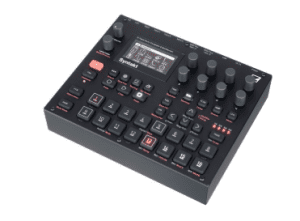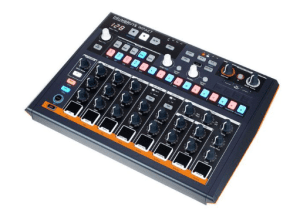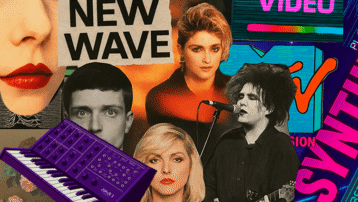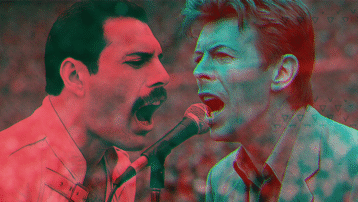We love drummers, of course! But even they like to use drum machines from time to time. In the right hands, these devices have shaped the sound of many classic hits. We’ve put together a list of some of the most iconic drum machine tracks, along with some current product suggestions. Check out our list below! 👇
Phil Collins – In the Air Tonight (1981)
While the song is most famous for Phil Collins’ monumental tom fill, two drum machines do the heavy lifting. The track begins with a preset pattern (“Disco 2”) from the Roland CR-78, a cube-shaped analogue drum machine released in 1978. If you listen carefully, you’ll notice an additional snare drum, which, according to various sources, comes from the Linn LM-1. By the way: Contrary to popular opinion, the acoustic snare played by Phil Collins after the drum break does not use gated reverb! Instead, they worked with multiple mics, a good helping of compression, and simple noise gates at the end of the signal chain.

You are currently viewing a placeholder content from YouTube. To access the actual content, click the button below. Please note that doing so will share data with third-party providers.
New Order – Blue Monday (1983)
Let’s move on to the best-selling maxi single of all time. In “Blue Monday”, an Oberheim DMX plays an instrumental role with an instantly recognizable 16th-note bass drum pattern. Inspired by Donna Summer’s song “Our Love”, this beat ensures that you know which song is playing after the first two bars. A lesser-known fact is that the bass drum was played through a monitor speaker and then re-recorded with a microphone to capture the ambient sound. On a side note: the synths actually start in the “wrong” place because Gillian Gilbert made a programming mistake while feeding the notes into the sequencer. The band liked it and decided to keep it as a stylistic device.

You are currently viewing a placeholder content from YouTube. To access the actual content, click the button below. Please note that doing so will share data with third-party providers.
Queen – Radio Gaga (1984)
Roger Taylor created the demo of “Radio Gaga” on a LinnDrum and a synthesizer before the rest of the band completed the song. The LinnDrum can also be heard in the finished production. According to unconfirmed sources, Queen also overdubbed synth drums from a Kurzweil K250, Simmons sounds, and acoustic cymbals. While the K250 wasn’t officially released until after the recording sessions, prototypes were already circulating, so it’s quite possible that it was already in Queen’s studio in the autumn of 1983.

You are currently viewing a placeholder content from YouTube. To access the actual content, click the button below. Please note that doing so will share data with third-party providers.
Depeche Mode – Enjoy the Silence (1990)
If any band was famous for relying heavily on drum machines in the 80s, it was Depeche Mode. Leading up to the release of their 1990 album “Violator” – still considered by many to be their masterpiece –, they released “Enjoy the Silence” as the second pre-release single. The drums come from several different sources, which is due to how the song came to be. While Martin Gore had originally written it as a ballad, Alan Wilder and Daniel Miller, the head of Mute Records, suggested turning it into a faster disco number, as producer Flood revealed in his masterclasses. Sources say that it took Martin Gore a very long time to get used to the idea. In the process of transforming the song, they simply sampled drums from an old disco track. Flood never confirmed where these drums came from, but according to various sources, it seems to be the extended House Mix of “That’s the Way Love is” by Ten City. In addition, various drum machine sounds were used, most notably a Roland TR-909 snare drum processed through an AKAI S1000 sampler. There’s also a tambourine that sounds a lot like the one from the Roland R-8 released in 1989, complemented by 909 hi-hats and typical Roland percussion.

You are currently viewing a placeholder content from YouTube. To access the actual content, click the button below. Please note that doing so will share data with third-party providers.
The Human League – Don’t You Want Me (1981)
It’s much easier in the case of this classic, as The Human League listed the devices used on the album. That said, the information was given for the entire album, not for the individual songs. But we can be certain that the Linn LM-1 was used here – the distinctly tuned hi-hat gives it away. The LM-1 has an unmistakable groove, which results from the fact that Roger Linn didn’t trim the samples perfectly. Rather than cutting the samples exactly at the start of each sound, he left a short period of silence at the beginning. But it’s not the same for every sample! That’s why beats from the LM-1 always sound a little bit “off” – but that special groove became an important part of the drum machine’s character. And it’s all over “Don’t You Want Me”.
You are currently viewing a placeholder content from YouTube. To access the actual content, click the button below. Please note that doing so will share data with third-party providers.
Source: https://youtu.be/JR4WCPY4mBY from 6:45 min
Prince – When Doves Cry (1984)
Another song that benefits from this groove is “When Doves Cry” by Prince, which also uses the Linn LM-1. Prince was an early adopter of the drum machine, and Roger Linn once revealed in an interview that this fact helped to sell it. While other musicians mainly relied on drum machines for demos back then, Prince saw them as a completely new and unique sound element that he wanted to use in his productions. In the same interview, Roger Linn also explained the difference between a drum machine and a drum computer: according to him, “drum machine” is the overarching product category. But he called the LM-1 “drum computer” because it came at a time when developers began adding computer chips to their instruments to expand their capabilities.
You are currently viewing a placeholder content from YouTube. To access the actual content, click the button below. Please note that doing so will share data with third-party providers.
Tame Impala – Let It Happen (2015)
Is it a drum machine or an acoustic drum kit? While “Let It Happen” by Kevin Parker’s Australian psychedelic rock project features a multi-layered production style, we can be sure that the sounds of the Sequential Circuits Drumtraks from 1984 can be heard in it. Its use on the album “Currents” is confirmed. This drum machine was one of the first after the Roland TR-909 to come with a built-in MIDI interface, so it could be synced via MIDI clock. The Drumtraks also lets you trigger its sounds via MIDI note messages – including velocity, which is not possible with the trigger buttons on the unit itself. Another special feature is that the pitch of the sounds is easily adjustable via MIDI. An often underestimated machine that was used by many artists, such as Daft Punk.
You are currently viewing a placeholder content from YouTube. To access the actual content, click the button below. Please note that doing so will share data with third-party providers.
Kraftwerk – from Autobahn (1974) to Pocket Calculator (1981)
Kraftwerk have always made a bit of a secret of their equipment. Many of their drum sounds were their own custom synth patches, which made them so unique at the time. But Kraftwerk also famously used a few drum machines. For example, the Farfisa Rhythm Unit 10 and the Vox Percussion King were used on “Autobahn”. However, they were heavily modified so that they could be played with Kraftwerk’s custom drum pads. The use of a Mattel toy keyboard for the song “Pocket Calculator” (“Taschenrechner”) is also well documented. The Bee Gees Rhythm Machine has a tunable sound for the mini keyboard and three rhythm patterns: “Disco”, “Latin”, and “Pop”. It may be a long shot to call it a drum machine, but Kraftwerk used it as one.

You are currently viewing a placeholder content from YouTube. To access the actual content, click the button below. Please note that doing so will share data with third-party providers.
Source: https://youtu.be/nwIOsrVXy8s
Talking Heads – Psycho Killer (Live 1984)
Sometimes it can be so simple! A beat, a guitar, and the incomparable voice of David Byrne – that’s all it takes to create a perfect rendition of a cult classic. While this track by the new wave and art punk band was originally released on their debut album in 1977, the 1984 live version features a perfectly programmed Roland TR-808, driving the song with its distinctive sounds. The rimshot and cowbell – two sounds of the 808 that are among the most iconic and recognizable drum computer sounds – are used to great effect here.

You are currently viewing a placeholder content from YouTube. To access the actual content, click the button below. Please note that doing so will share data with third-party providers.
Joe Smooth – Promised Land (1987)
This legendary house track features the Roland TR-707 – and lots of it. It’s almost like Joe Smooth was determined to use all the sounds of this digital drum machine from 1985 in the first eight bars of the club mix. The 707 is a machine based on 8-bit samples with a sampling frequency of 24 kHz, which is low by today’s standards. And yet – or perhaps because of this – it has an extremely assertive sound. And compare the kick, snare, and clap of the TR-707 with those of the song “Thriller” by Michael Jackson. That can’t be a coincidence, can it? As a big house classic, “Promised Land” has been covered numerous times. The hit version by The Style Council (including the “Father of Britpop” Paul Weller) replaced the TR-707 with a TR-909 sound. More recently, the Disco Boys, Jay Frog, and Fabrizio Levita gave the song a contemporary twist in 2022.
You are currently viewing a placeholder content from YouTube. To access the actual content, click the button below. Please note that doing so will share data with third-party providers.
Version by The Disco Boys, Jay Frog & Fabrizio Levita: https://youtu.be/5GrQxP-Z-7c
Molchat Doma – Volny (2018)
Founded in Minsk, Belarus, the dark wave and post-punk band Molchat Doma loves to use classic drum machine sounds for their beats, from the Roland TR-909 to the Alesis HR16 to the Akai MPC. “Volny” prominently features one of the favourite drum machines of guitarist, synthesist, and drum machine player Roman Komogortsev: the E-mu Drumulator. The characteristic toms, the dry and thumping bass drum, and the reverb-laden snare immediately evoke an 80s wave atmosphere. The band lives in Los Angeles and released their fourth studio album in 2024.

You are currently viewing a placeholder content from YouTube. To access the actual content, click the button below. Please note that doing so will share data with third-party providers.
Marvin Gaye – Sexual Healing (1982)
The Roland TR-808 is one of the most famous drum machines of all time. Countless artists have used it, from Run DMC to Whitney Houston, Daft Punk, and Afrika Bambaataa. To this day, it can be heard again and again in current productions. Its ultra-deep bass drum, the crisp, short snare, and of course the legendary cowbell always stand out immediately. But hardly anyone has ever used this 1980 drum machine classic as casually as Marvin Gaye in his 1982 hit “Sexual Healing”. He programmed the beat with his drummer in his new home in Ostend, Belgium, where he had moved after separating from his wife and his label Motown Records. It was worth it: “Sexual Healing” won two Grammys, Marvin Gaye was once again a celebrated soul star, and the song is regarded as the breakthrough and first big hit of the TR-808.

You are currently viewing a placeholder content from YouTube. To access the actual content, click the button below. Please note that doing so will share data with third-party providers.
Lebanon Hanover – Gallowdance (2013)
Long gone are the days when home recording was synonymous with amateurism. Even back in 2013, Lebanon Hanover recorded their song “Gallowdance” at home. The duo consisting of Larissa Iceglass from Switzerland and William Maybelline from Sunderland in England used the Yamaha RX11 drum machine, which had kicked off the RX series in 1984 and is now regarded as an icon of post-punk drum sounds. And “Gallowdance” may well have contributed to this, as the club hit is not only Lebanon Hanover’s greatest hit, but has achieved classic status in the dark wave scene.

You are currently viewing a placeholder content from YouTube. To access the actual content, click the button below. Please note that doing so will share data with third-party providers.
Cameo – Word Up (1986)
This song, which has been covered and remixed many times, has long been a true classic. To this day, new versions are constantly being released, making it an integral part of today’s club culture. The original featured the Yamaha RX5. Released in 1986, this drum machine sounded ultra-realistic for its time and offers many possibilities for tweaking the sounds. You can even load additional sounds via memory cards. The 808 and 909 may have been released in the 80s, but they didn’t become cult until the 90s. The RX5, on the other hand, had a firm grip on pop music in the second half of the 80s, only to disappear into oblivion a few years later. It was recently rediscovered by EDM producers and can now be heard from time to time in current productions.
You are currently viewing a placeholder content from YouTube. To access the actual content, click the button below. Please note that doing so will share data with third-party providers.
Pete Rock & CL Smooth – They Reminisce Over You (T.R.O.Y.) (1992)
The E-mu SP-1200 from 1987 and its direct predecessor, the SP-12 (1985), were the machines that popularized sampling in hip-hop, even before the Akai MPC. Pete Rock, Wu-Tang Clan, and A Tribe Called Quest all used them to create groundbreaking songs, sometimes even without any additional gear. With their characteristic 12-bit sound, these machines are unmistakably punchy, as can be heard in “They Reminisce Over You (T.R.O.Y.)” – a song that is still considered to be hip-hop in its purest and best form. A little side note: What does the SP-12 have in common with the best-selling home computer of all time? The connection for the 1541 floppy disc drive, which originated from the Commodore 64. This drive, which, by the way, runs just as notoriously slowly on the E-mu SP-12 as on the computer, was widespread when the drum machine was released in 1985. The SP-1200 replaced it with a built-in 3.5” floppy disc drive.
You are currently viewing a placeholder content from YouTube. To access the actual content, click the button below. Please note that doing so will share data with third-party providers.
Daft Punk – Revolution 909 (1997)
What would a list like this be without the Roland TR-909? Released in 1984, this drum machine not only shaped the sound of the 90s, it was also largely responsible for the sound of techno. Its sounds have been sampled again and again, reworked, remixed, and can still be heard on current productions in a wide variety of musical genres. Daft Punk paid homage to the 909 by naming an iconic track after it: “Revolution 909”. The fifth single from their debut album “Homework”, the track is based on a sample from the remix of the song “Celebration” by the Eurodance band Fun Factory, produced by Mousse T. Here, the 909 is mixed rather cleanly and not as brutally as in many techno tracks. But “Revolution 909” shows Daft Punk’s origins and roots in club music long before they made a name for themselves with chart-compatible songs.


You are currently viewing a placeholder content from YouTube. To access the actual content, click the button below. Please note that doing so will share data with third-party providers.
Drum Machines & Drum Computers: Your Favorite Song?
There are hundreds of drum machines, so we were only able to present a small selection of the most iconic ones here. Do you have a favorite of your own? Let us know in a comment!















Comments 1